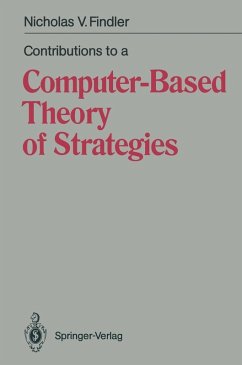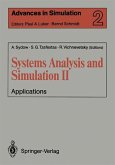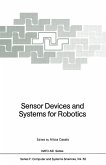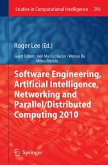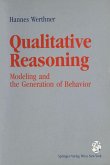Nicholas V. Findler
Contributions to a Computer-Based Theory of Strategies (eBook, PDF)
40,95 €
40,95 €
inkl. MwSt.
Sofort per Download lieferbar

20 °P sammeln
40,95 €
Als Download kaufen

40,95 €
inkl. MwSt.
Sofort per Download lieferbar

20 °P sammeln
Jetzt verschenken
Alle Infos zum eBook verschenken
40,95 €
inkl. MwSt.
Sofort per Download lieferbar
Alle Infos zum eBook verschenken

20 °P sammeln
Nicholas V. Findler
Contributions to a Computer-Based Theory of Strategies (eBook, PDF)
- Format: PDF
- Merkliste
- Auf die Merkliste
- Bewerten Bewerten
- Teilen
- Produkt teilen
- Produkterinnerung
- Produkterinnerung

Bitte loggen Sie sich zunächst in Ihr Kundenkonto ein oder registrieren Sie sich bei
bücher.de, um das eBook-Abo tolino select nutzen zu können.
Hier können Sie sich einloggen
Hier können Sie sich einloggen
Sie sind bereits eingeloggt. Klicken Sie auf 2. tolino select Abo, um fortzufahren.

Bitte loggen Sie sich zunächst in Ihr Kundenkonto ein oder registrieren Sie sich bei bücher.de, um das eBook-Abo tolino select nutzen zu können.
This monograph gives a systematic overview of the theory of strategies, a new area of enquiry developed by the author over the past two decades. The projects described have applications in air traffic control, verification and validation of simulation models, econometric model building, distributed planning systems for manufacturing, and others.
- Geräte: PC
- ohne Kopierschutz
- eBook Hilfe
- Größe: 30.17MB
Andere Kunden interessierten sich auch für
![Systems Analysis and Simulation II (eBook, PDF) Systems Analysis and Simulation II (eBook, PDF)]() Systems Analysis and Simulation II (eBook, PDF)72,95 €
Systems Analysis and Simulation II (eBook, PDF)72,95 €![3D Dynamic Scene Analysis (eBook, PDF) 3D Dynamic Scene Analysis (eBook, PDF)]() Zhengyou Zhang3D Dynamic Scene Analysis (eBook, PDF)40,95 €
Zhengyou Zhang3D Dynamic Scene Analysis (eBook, PDF)40,95 €![Sensor Devices and Systems for Robotics (eBook, PDF) Sensor Devices and Systems for Robotics (eBook, PDF)]() Sensor Devices and Systems for Robotics (eBook, PDF)40,95 €
Sensor Devices and Systems for Robotics (eBook, PDF)40,95 €![Catalogue of Artificial Intelligence Tools (eBook, PDF) Catalogue of Artificial Intelligence Tools (eBook, PDF)]() Catalogue of Artificial Intelligence Tools (eBook, PDF)72,95 €
Catalogue of Artificial Intelligence Tools (eBook, PDF)72,95 €![Software Engineering, Artificial Intelligence, Networking and Parallel/Distributed Computing 2010 (eBook, PDF) Software Engineering, Artificial Intelligence, Networking and Parallel/Distributed Computing 2010 (eBook, PDF)]() Software Engineering, Artificial Intelligence, Networking and Parallel/Distributed Computing 2010 (eBook, PDF)72,95 €
Software Engineering, Artificial Intelligence, Networking and Parallel/Distributed Computing 2010 (eBook, PDF)72,95 €![Qualitative Reasoning (eBook, PDF) Qualitative Reasoning (eBook, PDF)]() Hannes WerthnerQualitative Reasoning (eBook, PDF)72,95 €
Hannes WerthnerQualitative Reasoning (eBook, PDF)72,95 €![Artificial Intelligence in Design '00 (eBook, PDF) Artificial Intelligence in Design '00 (eBook, PDF)]() Artificial Intelligence in Design '00 (eBook, PDF)160,95 €
Artificial Intelligence in Design '00 (eBook, PDF)160,95 €-
-
-
This monograph gives a systematic overview of the theory of strategies, a new area of enquiry developed by the author over the past two decades. The projects described have applications in air traffic control, verification and validation of simulation models, econometric model building, distributed planning systems for manufacturing, and others.
Dieser Download kann aus rechtlichen Gründen nur mit Rechnungsadresse in A, B, BG, CY, CZ, D, DK, EW, E, FIN, F, GR, HR, H, IRL, I, LT, L, LR, M, NL, PL, P, R, S, SLO, SK ausgeliefert werden.
Produktdetails
- Produktdetails
- Verlag: Springer Berlin Heidelberg
- Seitenzahl: 282
- Erscheinungstermin: 6. Dezember 2012
- Englisch
- ISBN-13: 9783642757365
- Artikelnr.: 53176532
- Verlag: Springer Berlin Heidelberg
- Seitenzahl: 282
- Erscheinungstermin: 6. Dezember 2012
- Englisch
- ISBN-13: 9783642757365
- Artikelnr.: 53176532
- Herstellerkennzeichnung Die Herstellerinformationen sind derzeit nicht verfügbar.
1. Introduction.- 2. Basic Concepts of Strategies, Decision Making, and Planning.- 3. The Quasi-Optimizer (QO) System.- 3.1. Introduction and Research Objectives.- 3.2. A Brief Survey of Related Work.- 3.3. The Approach.- 3.4. System Modules.- 3.5. The Implementation.- 3.6. Applications.- 3.7. Summary.- 3.8. Acknowledgements.- 4. The Advice Taker/Inquirer (AT/I).- 4.1. Introduction and Research Objectives.- 4.2. The Approach.- 4.3. The Implementation.- 4.4. Benefits of Using the AT/I.- 4.5. Applications in Assembly Line Balancing and Street Traffic Light Control.- 4.6. Summary.- 4.7. Acknowledgements.- 5. The Generalized Production Rule System (GPRS).- 5.1. Introduction and Research Objectives.- 5.2. The Approach.- 5.3. System Modules.- 5.4. The Implementation.- 5.5. Applications.- 5.6. Summary.- 5.7. Acknowledgements.- 6. Distributed Planning and Problem Solving Systems (DPPSS).- 6.1. Introduction and Research Objectives.- 6.2. A Distributed System for Air Traffic Control.- 6.3. A Distributed System for Manufacturing Control.- 6.4. A System for Distributed and Moving Resources and Tasks.- 6.5. A Distributed System for Street Traffic Light Control.- 6.6. Summary.- 6.7. Acknowledgements.- 7. Causal Modelling Systems (CMS and NEXUS).- 7.1. Introduction and Perspectives on Causation.- 7.2. The Causal Modelling System CMS.- 7.3. The Causal Modelling System NEXUS.- 7.4. Summary.- 7.5. Acknowledgements.- 8. The Predictive Man-Machine Environment (PMME).- 8.1. Introduction and Research Objectives.- 8.2. The Simulated Air Traffic Control Environment.- 8.3. An Evaluation of the Predictive Man-Machine Environment.- 8.4. Summary.- 8.5. Acknowledgements.- 9. Overall Summary.- References.
1. Introduction.- 2. Basic Concepts of Strategies, Decision Making, and Planning.- 3. The Quasi-Optimizer (QO) System.- 3.1. Introduction and Research Objectives.- 3.2. A Brief Survey of Related Work.- 3.3. The Approach.- 3.4. System Modules.- 3.5. The Implementation.- 3.6. Applications.- 3.7. Summary.- 3.8. Acknowledgements.- 4. The Advice Taker/Inquirer (AT/I).- 4.1. Introduction and Research Objectives.- 4.2. The Approach.- 4.3. The Implementation.- 4.4. Benefits of Using the AT/I.- 4.5. Applications in Assembly Line Balancing and Street Traffic Light Control.- 4.6. Summary.- 4.7. Acknowledgements.- 5. The Generalized Production Rule System (GPRS).- 5.1. Introduction and Research Objectives.- 5.2. The Approach.- 5.3. System Modules.- 5.4. The Implementation.- 5.5. Applications.- 5.6. Summary.- 5.7. Acknowledgements.- 6. Distributed Planning and Problem Solving Systems (DPPSS).- 6.1. Introduction and Research Objectives.- 6.2. A Distributed System for Air Traffic Control.- 6.3. A Distributed System for Manufacturing Control.- 6.4. A System for Distributed and Moving Resources and Tasks.- 6.5. A Distributed System for Street Traffic Light Control.- 6.6. Summary.- 6.7. Acknowledgements.- 7. Causal Modelling Systems (CMS and NEXUS).- 7.1. Introduction and Perspectives on Causation.- 7.2. The Causal Modelling System CMS.- 7.3. The Causal Modelling System NEXUS.- 7.4. Summary.- 7.5. Acknowledgements.- 8. The Predictive Man-Machine Environment (PMME).- 8.1. Introduction and Research Objectives.- 8.2. The Simulated Air Traffic Control Environment.- 8.3. An Evaluation of the Predictive Man-Machine Environment.- 8.4. Summary.- 8.5. Acknowledgements.- 9. Overall Summary.- References.
